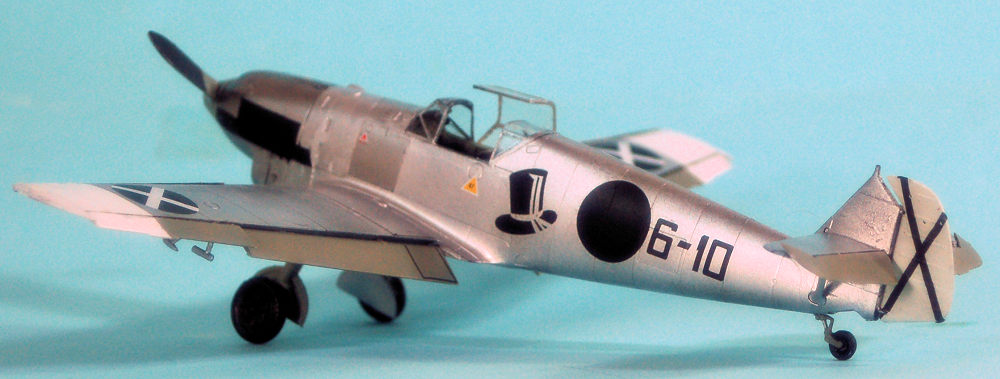
Dora Wings 1/48 Bf-109A
| KIT #: | 48009 |
| PRICE: | £17-00 for basic kit |
| DECALS: | Four options |
| REVIEWER: | Tom Cleaver |
| NOTES: | Rerelease of AMG kit |

| HISTORY |
Messerschmitt began work in 1933 on a four passenger light “sporting aircraft” of cantilever low wing monoplane design, with retractable landing gear. The BFW M.37 was completed in the spring of 1934. Later redesignated Bf 108 Taifun ("Typhoon"), it was entered in the fourth Challenge de Tourisme Internationale. While it did not win any of the events, its performance impressed the Reichluftfartministerium sufficiently to earned the Bf-108 a production contract.
Before the Bf 108 had made its first flight, Messerschmitt learned the
RLM was about to issue a new specification for a modern fighter, to be powered
by the Junkers Jumo 210 and to be capable of at least 280 mph. Officially, most
German aircraft manufacturers were invited to submit designs; unofficially, only
Arado, Heinkel, Fieseler or Focke Wulf could expect serious consideration.
Erhard Milch, who hated Willi Messerschmitt and had done everything he could to
destroy Messerschmitt's business, did not even inform the company of the
competition. However, unknown to Milch, Hermann Göring, had sent a
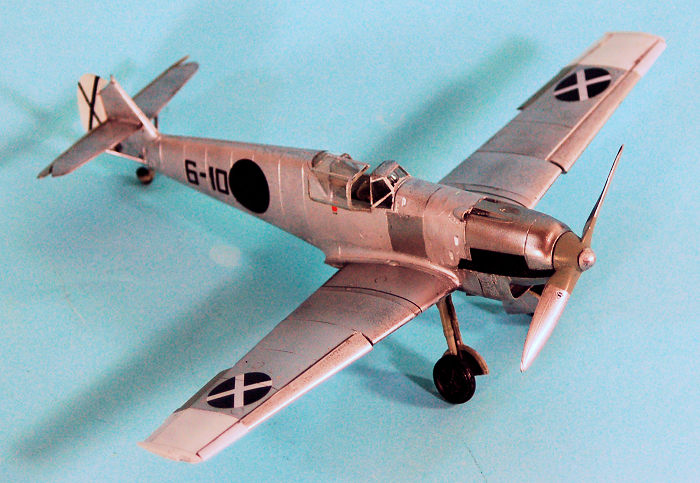 confidential
message to Messerschmitt, ordering him to develop "a lighting fast courier plane
which needs only to be a single seater." It was obvious to Messerschmitt that
Göring wanted to see him produce a fighter.
confidential
message to Messerschmitt, ordering him to develop "a lighting fast courier plane
which needs only to be a single seater." It was obvious to Messerschmitt that
Göring wanted to see him produce a fighter.
The design team at BFW's Augsburg factory - Robert Lusser, Richard Bauer and Hubert Bauer commenced the design of a single-seater that would incorporate the Bf 108's features: a monoplane with retractable landing gear, enclosed cockpit, leading edge slots and trailing edge flaps. It was known as Projekt P.1034.
The Bf 109V1 rolled out on August 5, 1935, powered by a583 hp Rolls Royce Kestrel engine in place of the unavailable Jumo 210. Evaluation flights began at Rechlin and revealed the Bf-109 to be in advance of anything else flying. The Bf 109V2, which appeared in October, introduced the 610 hp Jumo 210A as well as a strengthened undercarriage, while the Bf 109V 3, delivered in June 1936, was the first to be armed with an engine mounted 7.92mm MG 17 machine gun.
Luftwaffe pilots were at first afraid of the airplane, and the thoroughly-pedestrian Heinkel He-112, with a low landing speed and an open cockpit, appeared to be the winner until Ernst Udet flew the Bf-109V2 and declared it superior to all others in the competition. Twenty pre-production Bf 109As were ordered in the summer of 1936, followed shortly by two events that would affect the Bf 109's fate.
In June 1936, the same month that the Bf-109 entered pre-production, the Royal Air Force announced production contracts for 600 Hawker Hurricane fighters and 310 Supermarine Spitfires. The threat posed by those new British fighters added urgency to Germany's fighter development efforts.
The other major event was the revolt of conservative elements under General Francisco Franco y Bahamonde against the Republican government of Spain in July, 1936, followed by the dispatch of German aircraft to Franco's aid.
That November, Luftwaffe volunteers were assigned to the Condor Legion to fight for Franco's Nationalists. At about the same time, the Soviet Union sent aircraft and pilots to aid the Spanish Republic, including the Polikarpov I-15 biplane and the I-16, the world's first low wing monoplane fighter with retractable landing gear and an enclosed canopy. Both Soviet fighters completely outclassed the Condor Legion's Heinkel He 51 biplanes.
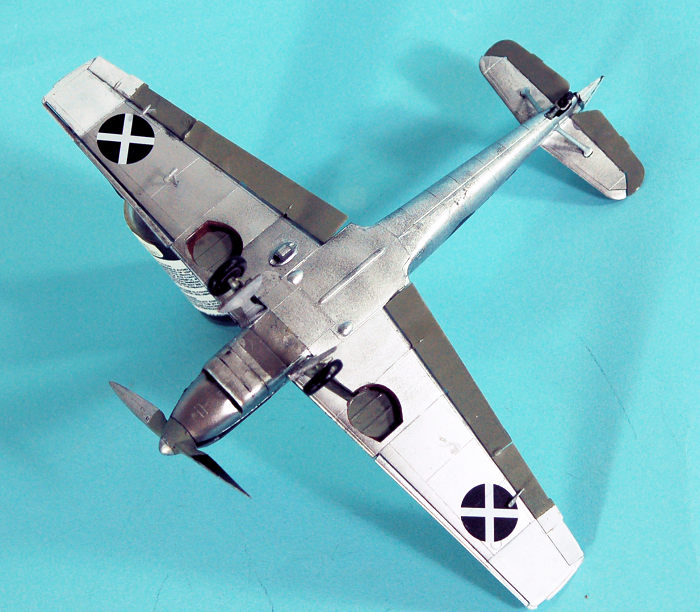 As a result, the Luftwaffe rushed the Bf 109V4 to Spain in December,
1936, followed in January by the V3 and V6 prototypes, and 15 Bf-109A fighters,
the first of which left the production line in February 1937. In May, the first
of 55 Bf-109B fighters arrived; the first 12 of these were assigned to 1.J/88,
with the rest assigned to both squadrons as they arrived.
As a result, the Luftwaffe rushed the Bf 109V4 to Spain in December,
1936, followed in January by the V3 and V6 prototypes, and 15 Bf-109A fighters,
the first of which left the production line in February 1937. In May, the first
of 55 Bf-109B fighters arrived; the first 12 of these were assigned to 1.J/88,
with the rest assigned to both squadrons as they arrived.
The Condor Legion's first operational unit to fly the Bf-109, 2. Staffel of Jagdgruppe 88 (2.J/88) commanded by Oberleutnant Günther Lützow, began receiving the new Bf-109s in March, 1937. The unit was initially plagued by accidents, but the pilots soon met the challenge of taking off and landing on a narrow track undercarriage in an airplane that tended to drop its left wing, applying plenty of compensation with the rudder.
Lützow scored the first victory for the 109 on 6 April 1937. By the end of the month, a further three Republican aircraft had been shot down by pilots in Bf-109s. The squadron flew as escorts to the Ju-52/3m’s of Kamgeschwader 88 during the infamous bombing of Guernica on 26 April.
In July, 2.J/88 was transferred from Bilbao to Brunete, to face a Republican offensive. It was now that the I-15 and I-16 fighters were finally met in combat. On 12 July a full fight took place, with Unteroffizier Guido Honess, flying Bf-109A “6-4," falling victim to an I-16. A second fight on 17 July saw Olympic pentathlon winner Leutnant Gotthard Handrik shot down by American volunteer Frank Tinker, flying an I-16; Handrick survived by bailing out. The next day, Unteroffizier Haarbach was shot down and wounded.
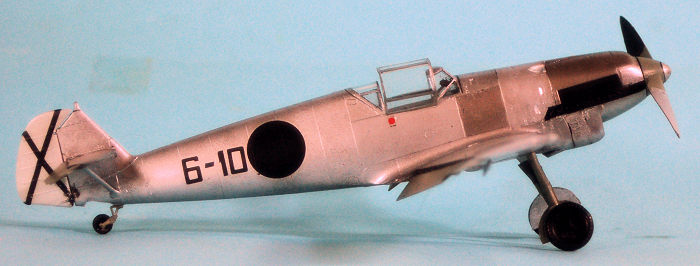 Over the course of July, 2.J/88 scored eight Republican victories. With
the Brunete offensie halted, the squadron was sent back to Vitoria to cover the
Nationalist offensive that ended with the fall of Santander at the end of August
and Gijon in late October, giving the Nationalists control of the entire
Biscayan coast. Hajo Harder’s 1.J/88 joined 2.J/88 during this offensive, which
saw the German fighter come into its own in combat with the Soviet fighters
flown by the Republicans.
Over the course of July, 2.J/88 scored eight Republican victories. With
the Brunete offensie halted, the squadron was sent back to Vitoria to cover the
Nationalist offensive that ended with the fall of Santander at the end of August
and Gijon in late October, giving the Nationalists control of the entire
Biscayan coast. Hajo Harder’s 1.J/88 joined 2.J/88 during this offensive, which
saw the German fighter come into its own in combat with the Soviet fighters
flown by the Republicans.
1938 saw extensive combat as the Nationalists pushed toward the Mediterranean coast. During the year, German pilots began scoring regularly. By November 1938, when he was finally ordered home, Leutnant Werner Mölders had scored 14 victories to be the leading ace of the Condor Legion in Spain. When Bf-109E-3s began to arrive in early 1939, the surviving Jumo-powered Bf-109s were tranferred to the Nationalist Grupo 5-G-5. Of the 15 Bf-109As sent in 1937, seven were shot down during the war, with another three lost in operational accidents.
| THE KIT |
Kits of early Bf-109s have been thin on the ground, with only Hobbycraft releasing a series of early 109s 25 years ago; these were not terribly accurate. In 2004, Classic Airframes released an accurate early 109 that could be built as an A, B, C, or D sub-type. These have been unavailable since the company went out of business and now command collector’s prices.
Dora Wings is the new name of AMG, a Ukrainian company that released a
series of early 109s last year, each kit having the various differences between
sub-types, unlike the Hobbycraft early 109s which were basically the same kit in
a different box. At the time of their release, a well-known modeler at The Other
Place declared these kits “very difficult” and published photos of his model
with putty over every joint.
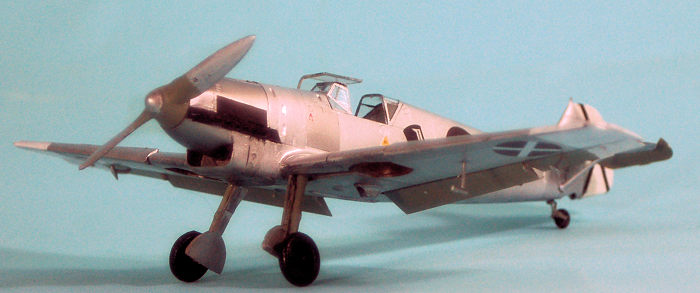 That was not my experience with the AMG kit, or
with this re-release by Dora Wings. If one takes the time to clean up parts -
particularly to getting rid of sprue nubs - and test-fitting and modifying where
necessary until satisfied with the fit before gluing, the result will be a model
that only requirs putty along the centerline of the upper cowling and the lower
radiator.
That was not my experience with the AMG kit, or
with this re-release by Dora Wings. If one takes the time to clean up parts -
particularly to getting rid of sprue nubs - and test-fitting and modifying where
necessary until satisfied with the fit before gluing, the result will be a model
that only requirs putty along the centerline of the upper cowling and the lower
radiator.
This Dora Wings kit differs from the earlier Bf-109A/B kit in that the decals are for 109s in the Spanish Civil War. Decals are provided for four aircraft, “6-10" which was flown by 2.J/88 commander Günther Lützow and “6-15,” which was flown by Oberfeldwebel Otto Polenz and was captured by the Republicans on 4 December 1937 when Polenz was shot down, later being transferred to the USSR for technical analysis. Both of these are in the early silver/NMF finish. The other decals are for two Bf-109B-1s in later camouflage of RLM 62/63/65 flown by 1.J/88. These are excellent decals that are thin and go on without difficulty.
| CONSTRUCTION |
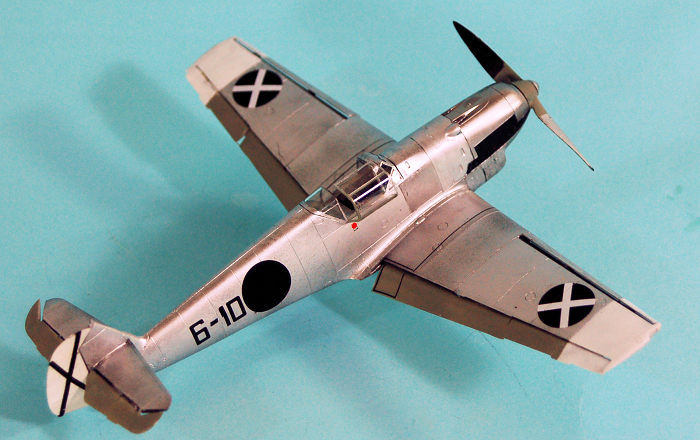 This is a limited-run kit and requires care in cleaning up parts and
test-fitting. Taking care here will result in a very nice model.
This is a limited-run kit and requires care in cleaning up parts and
test-fitting. Taking care here will result in a very nice model.
I first assembled the wing, which presented no problems at all; I kept the ailerons and flaps separate, since they would be painted RLM02, while the airframe would be painted in different metallic colors. I then painted and assembled the cockpit. I used Eduard seat belts. I fitted this inside the fuselage and glued the fuselage halves togeher. When that was set up, I glued the wing sub-assembly to the fuselage.
The nose is made up of eleven parts and is quite fiddly. I assembled the upper cowling parts as a sub-assembly, and the lower radiator housing also as a separate sub-assembly. When the fuselage was glued together, I first attached the radiator housing, then the upper engine cowling. I only needed filler along the centerline seams of these sub-assemblies.
| COLORS & MARKINGS |
 It is unclear whether the Bf-109As were delivered in natural metal
unpainted finish, or painted RLM01 Silver. Several photos in Lynn Ritger’s
Datafile “Part 1: Prototype fo E Variants” show what seems to be different hues
on different panels, so I decided it was likely NMF. I used Vellejo Acrylic
Metallics: Duraluminum for the engine cowling, White Aluminum for the wings and
horizontal stabilizers, Aluminum for the fuselage, and White Aluminum and
Duraliminum for the radiator housing. I first applied a primer coat of thinned
Tamiya Gloss Black, which gives a much smoother finish than the Vallejo black
primer. The fabric-covered control surfaces were painted with Xtracrylix RLM02.
It is unclear whether the Bf-109As were delivered in natural metal
unpainted finish, or painted RLM01 Silver. Several photos in Lynn Ritger’s
Datafile “Part 1: Prototype fo E Variants” show what seems to be different hues
on different panels, so I decided it was likely NMF. I used Vellejo Acrylic
Metallics: Duraluminum for the engine cowling, White Aluminum for the wings and
horizontal stabilizers, Aluminum for the fuselage, and White Aluminum and
Duraliminum for the radiator housing. I first applied a primer coat of thinned
Tamiya Gloss Black, which gives a much smoother finish than the Vallejo black
primer. The fabric-covered control surfaces were painted with Xtracrylix RLM02.
I chose to do “6-10,” the airplane flown by Günther Lützow (the kit painting instructions say it was flown by a different pilot, but Ritger identifies it as Lützow’s). The kit decals went on without difficulty, though I had to apply several coats of Solvaset to get them to snug down in the engraved panel lines.
I attached the landing gear, then attached the control surfaces. I unmasked the canopy and installed it in the open position.
| CONCLUSIONS |
This is not a “shake and bake” Tamiya kit, but it is well-designed and if you take your time in assembly, it goes together at least as well as the Zvezda 109s. The only “fiddly” part is the engine cowlings. Recommended for modelers who want to commit the revolutionary act of following the instructions and taking the time to do detail clean-up of the parts. The result is the best early 109 available.
Thanks to Dora Wings for the review kit.
mpeter 109 and a tropical filter from one of Hasegawa’s offerings.
The parirframe primed with Dark Grey auto primer applied from a rattle can. The areas of the rear fuselage and wing tips to be finished White were sprayed in Tamiya Fine White primer and masked over with Tamiya tape.
For the The final detail was to add the wing tip light covers.
| REFERENCES |
Res
November 2017
Copyright ModelingMadness.com
Project courtesy of my wallet.
Thanks to
for the preview kit. You can find this kit at your favorite hobby shop
or on-line retailer. If you would like your product reviewed fairly and
fairly quickly, please
contact
the editor or see other details in the
Note to
Contributors. Back to the Main Page
Back to the Review
Index Page
Back to the Previews Index Page